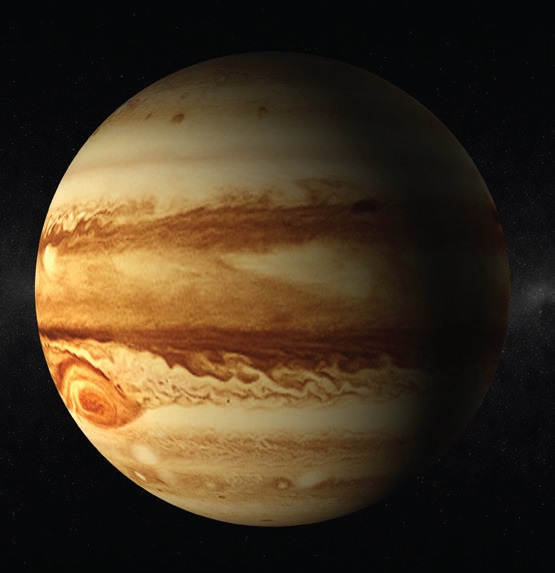Tribology and the Planets: Part 1
R. David Whitby | TLT Worldwide September 2019
Tidal friction could result in the destruction of Io, Jupiter’s innermost moon.

NASA’s Juno spacecraft entered a polar orbit around Jupiter on July 5, 2016.
© Can Stock Photo / sabinoparente
I have noted that tribology sometimes turns up in the most surprising places. I have found another one recently—Jupiter’s inner moon, Io.
Jupiter, the fifth planet from the Sun, is a huge gas giant. It is the largest planet in the solar system, with a mass two-and-a-half times that of all the other planets in the solar system combined. Although its volume is about 1,321 times that of the Earth, it is only 318 times as massive. Jupiter’s diameter is about a tenth that of the Sun, but its mass is 0.001 times that of the Sun, so the densities of the two bodies are similar.
At the last count, Jupiter has 79 moons. Most are small. The four largest were observed first by Galileo, so are known as the Galilean moons. They are among the largest satellites in the solar system. The innermost moon, Io, diameter 3,643 kilometers (2,264 miles), orbits an average of 422 thousand kilometers (about 262 thousand miles) from Jupiter’s surface. It is larger than Earth’s moon (diameter 3,474 kilometers, 2,159 miles) and orbits at about the same distance as the moon from Earth.
The other three large Galilean moons are Europa, diameter 3,122 kilometers (1,940 miles), Ganymede, diameter 5,268 kilometers (3,273 miles), and Callisto, diameter 4,821 kilometers (2,996 miles). Ganymede is larger than the planet Mercury.
Unlike most moons in the outer solar system, which are principally frozen ices, Io is mainly silicate rock, surrounding a molten core, which is largely iron. Io also is volcanically active, although it has no internal heat source, unlike Earth whose core is still undergoing nuclear fission.
Io’s orbit is profoundly influenced by Jupiter, Europa and Ganymede. The orbits of the three moons form a pattern known as a Laplace resonance. For every four orbits Io makes around Jupiter, Europa makes exactly two and Ganymede makes exactly one. This resonance causes the gravitational effects of the three moons to distort their orbits into elliptical shapes, because each moon receives an extra pull from its neighbors at the same point in every orbit it makes.
Jupiter’s overwhelming gravity on Io is supplemented by weaker and varying gravitational pulls from Europa and Ganymede. This results in huge tidal forces that stretch and squeeze Io. The tidal force from Jupiter works to circularize the three moons’ orbits.
The eccentricity of their orbits causes regular flexing of the three moons shapes, with Jupiter’s gravity stretching them out as they approach it and allowing them to spring back to more spherical shapes as they move away. This tidal flexing heats the moons’ interiors by friction. This is seen most dramatically in the extraordinary volcanic activity of innermost Io (which is subject to the strongest tidal forces), and to a lesser degree in the geological youth of Europa’s surface (indicating recent resurfacing of the moon’s exterior).
NASA launched Juno, a solar-powered spacecraft, on Aug. 5, 2011, as part of the New Frontiers program to begin a scientific investigation of Jupiter, continuing the mission of the earlier Galileo spacecraft. Juno entered a polar orbit around Jupiter on July 5, 2016. Juno’s mission is to measure Jupiter’s composition, gravity field, magnetic field and polar magnetosphere. It also will search for clues about how the planet formed, including whether it has a rocky core, the amount of water present within the deep atmosphere, its mass distribution and its deep winds, which can reach speeds up to 618 kilometers per hour (384 mph).
On Dec. 21, 2018, Juno’s cameras took pictures of Io as it entered Jupiter’s shadow but was illuminated softly by light reflecting off Europa. The pictures revealed a volcanic plume, shooting material into space for a distance of around 200 kilometers (124 miles). Observations from Earth and using Juno have found over 400 active volcanoes on Io. Several volcanoes produce plumes of sulfur and sulfur dioxide that are as high as 500 kilometers (311 miles) above the surface. Io’s volcanic plumes and lava flows produce a surface of various subtle shades of yellow, red, white, black and green, largely due to allotropes and compounds of sulfur. Numerous extensive lava flows, several more than 500 kilometers (311 miles) in length, also mark the surface. One lake of lava is over 200 kilometers (124 miles) in diameter.
All of this is the result of tidal friction. It is possible that the extreme gravitational forces may eventually tear Io apart.
David Whitby is chief executive of Pathmaster Marketing Ltd. in Surrey, England. You can reach him at pathmaster.marketing@yahoo.co.uk.